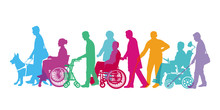Celebrating the 30th Anniversary of the Americans with Disabilities Act

July 26th, 2020 marked the thirty-year anniversary of the Americans with Disabilities Act (ADA) which made it illegal to discriminate against people based on a disability in areas including, but not limited to, employment, transportation, and public services. In an article, called “A Brief History of The Americans with Disabilities Act (ADA),” Jillian Abel provides some historical context about the passing of the law and how it has been influential in recent years. According to Abel, active support for those with disabilities had began as early as the 1960s and resulted in the passing of the 1973 Rehabilitation Act which banned discrimination based on disabilities for those receiving federal funding. Over the years, activism continued and would eventually lead to the passing of the ADA. Since then the ADA has continued to make updates to their regulations with the intent of providing as much participation and access of equal quality to all individuals.
Museums have gradually made changes to become more ADA compliant. In an article by NEA Director of Accessibility, Beth Bienvenu, “Museums and the Americans with Disabilities Act at 25: Progress and Looking Ahead,” some of the accommodations made by museums are discussed such as audio guides, tactile tours, captioned video, sign-language interpreted tours, and wheelchair access to all physical spaces. Despite these efforts, however, Bienvenu also explains that a 2012 Survey of Public Participation in the Arts found that “21 percent of all adults visited an art museum or gallery, but only 11 percent of adults with disabilities made such a visit.” She goes on, explaining that there is still more work to be done in order to provide more involvement for those with disabilities.
Last year, Claire Voon wrote an article, “Museums Are Finally Taking Accessibility for Visitors with Disabilities Seriously,” in which she discussed changes made by the Museum of Modern Art (MoMA) in order to better serve visitors with disabilities. One of the actions taken by MoMA was to invite ten individuals with different impairments to walk through their spaces. Voon discusses the MoMA’s decision in more detail, articulating that while museums attempt to be more accessible, they often fail to consider the various kinds of accommodations visitors might need. In many cases, it takes someone with a disability walking through a space to indicate that there is a problem with access or inclusion.

In many cases, museums have taken steps in the right direction to comply with the Americans with Disabilities Act and create more accessibility to their events and spaces. However, as many of the articles have stated above, there is still much work to be done. In my own experience, interactions I have had with individuals with different impairments has greatly increased my awareness of potential barriers within museum spaces. While my awareness has been increased, I do not always have ideas on how to solve the problem. This is where knowing what resources are available to you come in handy. Below are a few links which provide information on the Americans with Disabilities Act itself and ideas on how to create a more accessible institution.
- Museums and the Americans with Disabilities Act at 25: Progress and Looking Ahead
- Design for Accessibility: A Cultural Administrator’s Handbook
- Information and Technical Assistance on the Americans with Disabilities Act
- Maintaining Accessibility in Museums
Are there experiences you have from a visit to a museum you would like to share? Consider creating a guest post on our blog to further the discussion of accessibility and inclusivity.
Do you know of other useful resources that both current and future museum professionals could utilize to create more accessible environments? Please leave a comment below or send us a message through the “contact us” option located in the sidebar at right.